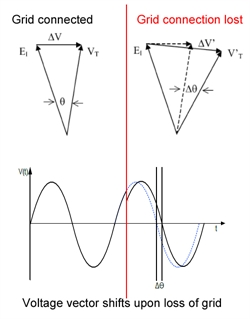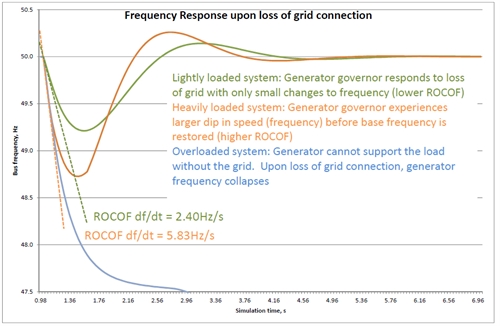Time's up for vector shift protection?
In distribution systems with local generation running in parallel with a grid supply, one method of detecting loss of mains is a vector shift relay (also known as phase angle or vector jump relay; ANSI code 78). These devices detect the sudden change in voltage cycle time caused when the system suddenly starts to import or export extra power from the local generator when the grid connection is lost (the “islanded” condition). Until recently, this has been the method of detecting islanding advocated by the UK Energy Networks Association (ENA).

(Right): There is a voltage difference between generator EMF (E1) and the terminal voltage (VT) caused by the winding impedance. When the grid connection is lost, the current through the winding impedance will change and hence so will the terminal voltage (V'T). This causes the vector shift.

The alternative to vector shift protection is a rate-of-change-of-frequency relay (ROCOF; ANSI code 81R). This function monitors the difference in frequency between the prime mover of the local generator and the network upon sudden increase or decrease in load (which is assumed to be caused by the loss of the grid connection). ROCOF protection will always operate more slowly than vector shift protection, since it must monitor the change in frequency over several cycles whereas vector shifts occur in the duration of a single cycle (0.02s for a 50Hz system).
The speed of response has made vector shift protection popular for detecting islanded power systems, but there are a number of cases where it can cause spurious trips:
- Phase-to-earth faults. If the fault impedance is low enough, sudden earthing of one phase in part of the distribution system can be interpreted by the vector shift relay as a sudden increase in load; this is less of a problem for ROCOF systems which operate more slowly and therefore allow time for the earth fault protection to clear the fault without tripping the generator. Of course, if the ROCOF setting is too sensitive or the earth fault protection too slow, the frequency protection relay may still trip.
- Phase-to-phase faults. This type of fault introduces phase shifts of different magnitudes in each of the three phases and therefore activates vector shift protection. ROCOF protection systems are generally set to allow for rapid changes in connected load and may not operate; in which case earth fault protection close to the fault should trip instead.
- Three-phase faults. All three phases will experience a significant vector shift and vector shift protection will trip. In this instance ROCOF protection is also likely to trip, depending on the strength of the network (and its ability to supply fault current).
- Voltage dips on the grid connection. Brief changes occur in the phase angles of each conductor both as the voltage drops and again when full rated voltage is restored. For sudden dips in voltage, the changes in phase angle can be sufficient to trip vector shift protection. Starting of large machines can also produce a similar brief voltage dip.
Investigations by the ENA in 2017* have determined that classic vector shift protection systems cause spurious trips in many common types of network disturbance. For this reason, amendments have been proposed to the G59/3 document (Recommendations for connecting generators to the UK grid) which would prevent any new vector shift protection being added to generator systems. The islanding detection system preferred by the ENA would be ROCOF alone.
So it might seem that vector shift protection is dead.
But wait; there are ways to make vector shift systems far more resilient to transient faults and still benefit from their fast response time. Most significant is voltage dip blocking. CEE’s NPV911 relay has a feature that will block the vector shift protection if the phase voltage has not dipped below a user-defined threshold. The majority of faults will involve an impedance, so the vector shift protection can be blocked; the greater the under-voltage set-point defined by the user, the more resilient the vector shift protection will be to other types of fault.
If the system frequency shifts slowly over time, the NP900 range of relays are designed to track the system frequency using a time average calculation. If activated, this feature will use the measured system frequency as the base for all internal calculations and protection functions.
Finally, the NPV911’s vector shift protection can be applied to any phase or neutral voltage input or all phases together; if one phase is prone to disturbances it can be excluded from the protection function.
Still not sold on vector shift protection? Many relays in the NP900 range (including the NPV911) have ROCOF protection with up to 8 set-points available as standard.
So it might seem that vector shift protection is dead.
But wait; there are ways to make vector shift systems far more resilient to transient faults and still benefit from their fast response time. Most significant is voltage dip blocking. CEE’s NPV911 relay has a feature that will block the vector shift protection if the phase voltage has not dipped below a user-defined threshold. The majority of faults will involve an impedance, so the vector shift protection can be blocked; the greater the under-voltage set-point defined by the user, the more resilient the vector shift protection will be to other types of fault.
If the system frequency shifts slowly over time, the NP900 range of relays are designed to track the system frequency using a time average calculation. If activated, this feature will use the measured system frequency as the base for all internal calculations and protection functions.
Finally, the NPV911’s vector shift protection can be applied to any phase or neutral voltage input or all phases together; if one phase is prone to disturbances it can be excluded from the protection function.
Still not sold on vector shift protection? Many relays in the NP900 range (including the NPV911) have ROCOF protection with up to 8 set-points available as standard.
*Amendments tabled by the ENA for the proposed third amendment to engineering recommendation G59 revision 3 . Please note that at the time of writing these amendments have not been formally issued.
The version in circulation at the time of writing is G59/3-2 (2015); some more information on connecting generators to the UK electricity grid is available here. There are some guidelines on using G59/3-2 available here.
The version in circulation at the time of writing is G59/3-2 (2015); some more information on connecting generators to the UK electricity grid is available here. There are some guidelines on using G59/3-2 available here.